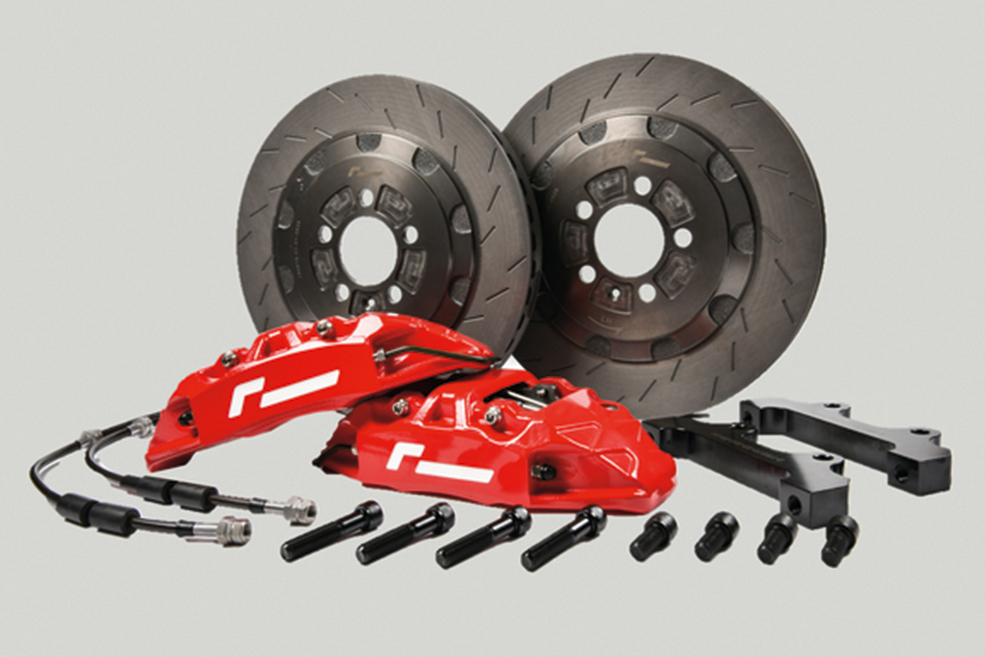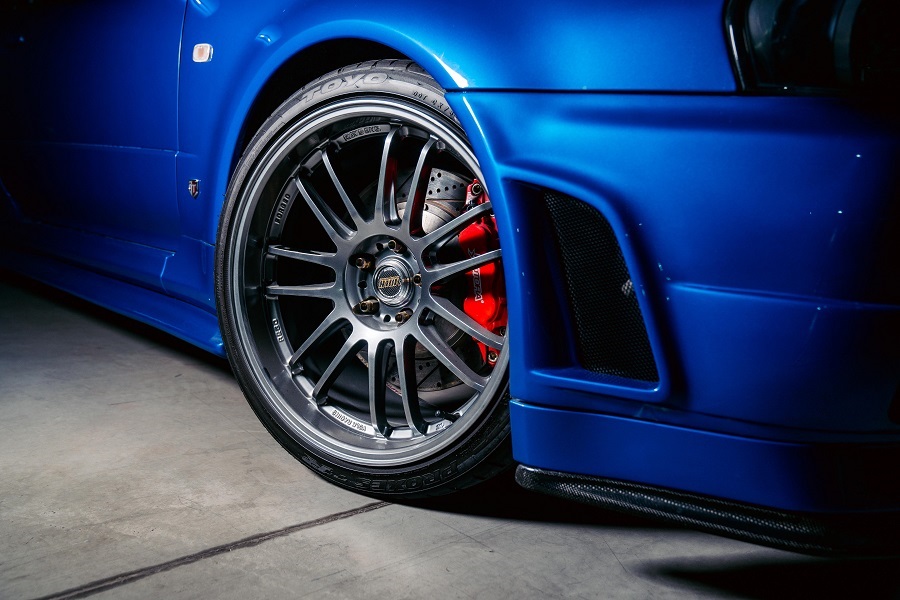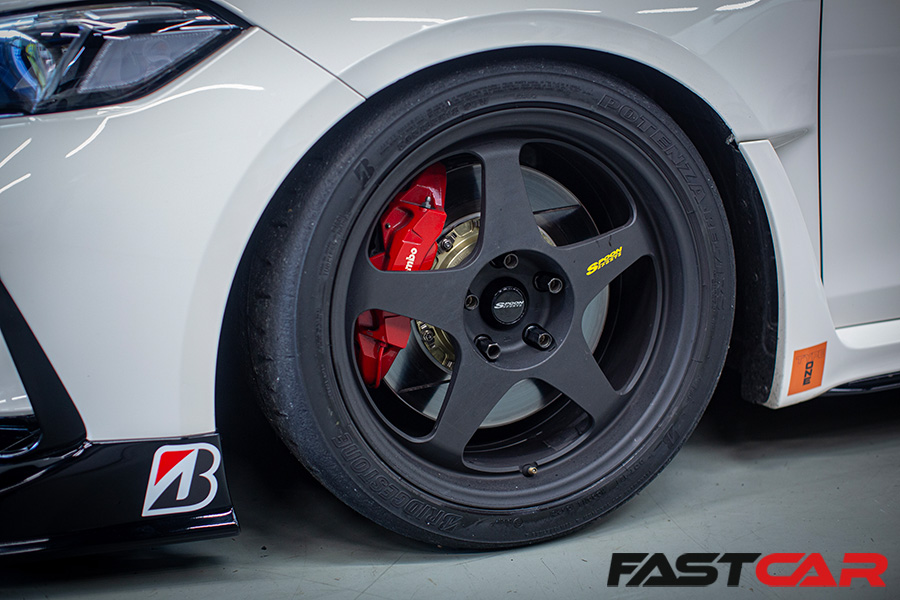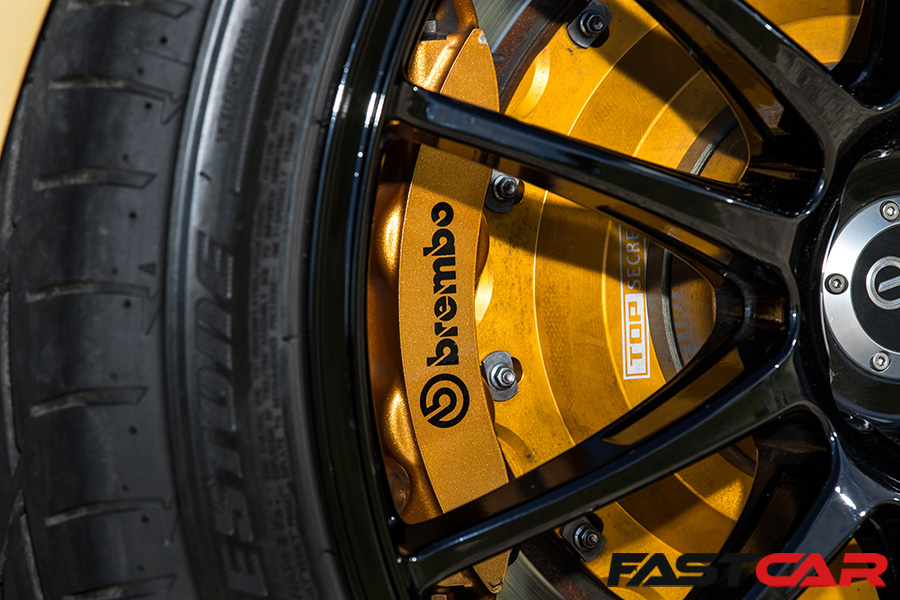Designed with superior performance in mind, we take a look at what big brake kits are and why people upgrade to them when modifying cars.
For those wanting some extra braking performance, your first step should always be uprated rotors and pads. However, for those serious about stopping, big brake kits are the next step. In this guide, we’ll talk you through what they are, why people upgrade to them and what you should consider before buying a set.
What are big brake kits and what do they do?
Big brake kits (BBKs) are essentially bigger, stronger and often lighter versions of your car’s existing brake setup. They consist of a pair of rotors that are often considerably larger in diameter than OEM items, are often of a two-piece construction with a central ‘bell’ bolted to a ventilated outer rotor (disc in the UK). The other parts of a BBK are the calipers, which contain multiple piston arrangements – four, six, eight and even ten or 12-piston designs are available – and a pair of application-specific extended mounting brackets for the caliper. Some kits also contain braided brake hoses too.
Be sure to check out our guide to the best big brake kits on sale today.
Are all big brake kits the same?
While practically all big brake kits use the same basic principle of a larger rotor and caliper setup, there can be a big difference in the construction and design of various kits. This can have a massive impact on a kit’s performance. For starters, there are different sized kits with four large pistons or up to 12 smaller ones – and while there is sometimes a case for the idea that bigger is better, just don’t fall for the theory that more pistons automatically equals greater performance, as it isn’t always the case. The diameter of the rotors can also vary, as can the design of ventilation of the rotors and the surface attributes such as drilling, grooving J-hooks or dimples. Because of these variances, big brake kits can also vary wildly in price.

What are big brake kits made of?
Most calipers are made from a two-piece cast construction, but higher-end kits come in a much stronger and stiffer one-piece forged monoblock design. This is where a forged piece of billet aluminum is heated to around 450C before being forged into the basic caliper shape in a press. The excess material is then removed and the final shaping of the caliper is completed by CNC machining. This single-piece forged process reduces weight while increasing strength. The bells are also produced by CNC machining, often out of the same billet aluminum as the calipers. The rotors are usually made from an iron-alloy, and cast in a mold before machining, but some high-end brake kits use carbon fiber or ceramic materials in the construction of their rotors.
How do they differ from OEM brakes?
Aside from the different construction methods, materials and the physical size of aftermarket big brake kits, as we’ve already described, the biggest benefit over OEM items is their resistance to fade and the ability to stop the car hard, repeatedly. Standard brakes will withstand a small number of high braking efforts from high speed but will then overheat, and the coefficient of friction will fall off a cliff. The reason BBKs don’t suffer in the same way is mainly due to the larger disc, caliper and pad sizes, which help keep the brake temperatures down. The pad materials used can run at a higher temperature range than OEM pads without fading. They are also often available in a variety of painted color options, with brands like KSport able to offer color-coding to your car or wilder options such as plated neochrome, gold or titanium.

Why would you need to upgrade to a big brake kit?
Basically, it is a wise decision to upgrade to a big brake kit whenever you feel you are approaching the limits of your current braking setup. Big brake kits offer vastly superior braking performance and are particularly suitable for track driving where the brakes are under much more stress than they would be during normal road driving conditions. Also, because of the materials used in their construction, big brake kits are also often lighter than factory options, so are a good way to not only increase stopping power but reduce unsprung weight too, which will also improve your car’s handling and performance.
How important is getting the right big brake kit?
As your car’s brakes are the only things that actually stop you from a potentially fatal accident, choosing the right brake kit for your car is crucial. The performance of the kit you choose needs to exceed combined weight and speed forces of your car, plus stand up to whatever abuse you throw at it in the form of extreme driving. But simply going for the biggest kit you can afford is not always the best solution, as the bigger the kit, the heavier it is likely to be too.
Ideally you want to select the smallest (or lightest) kit that still meets your performance criteria. Also, the bigger the kit, the larger wheels you will need to fit over them, so the cycle of weight gain continues. Often, big brake kit manufacturers develop kits for specific vehicles that take these elements into consideration and their model-specific options are suitable for most situations.

What causes factory brake setups to fail?
As a consumable component, by their very nature brake rotors and pads wear out and need replacing over the lifespan of the vehicle. Throw increased performance or more extreme driving situations (such as track driving) into the mix and this wear can be rapidly accelerated.
The other common problem with OEM brakes is their ability to deal with heat. Overheating of the brake system can reduce braking power. Excess heat can also cause the brake fluid to boil and introduce bubbles into the fluid, which reduces braking pressure and causes a spongy pedal.
Finally, corrosion to the cast iron calipers can cause the piston seals to perish and the pistons to corrode and seize inside the caliper body. A big brake kit’s billet aluminum construction and ventilated rotors means it has improved ability to deal with high temperatures and resists corrosion much better too.

What other mods should you consider?
Although many kits now come with them included, it’s always worth making sure you fit a set of braided brake lines at the same time as a big brake kit. This is because OEM brake lines are made of rubber and can flex under hard use, meaning you are not able to transmit the full braking force to the caliper. This, in turn, means you might not get the full benefit from the uprated brake kit.
Another thing worth considering when fitting a big brake kit is your tires, because any brake kit is only going to be as effective as the tires will allow, so make sure you are running suitable performance rubber with plenty of grip before making the step to drastically upgrade your car’s braking system.
Are there any downsides to big brake kits?
Big brake kits are a vital component to any serious fast-road or track car, but they can have their drawbacks. For starters, they can be pretty pricey, with a decent setup likely to cost well over $1000. Second, their sheer size can make wheel choice that bit more difficult as you need to ensure that any wheels you choose have large enough internal space to run clear of the enlarged calipers.
Finally, depending on what pads you choose, due to their more performance-biased nature, big brake kits are often more prone to the odd bit of brake squeal and can produce more dust. But these are seen as a minor trade-off for the huge increase in braking performance.
What are the most important things to look out for when buying a big brake kit?
There are various considerations that need to be made when choosing which kit to buy. The first consideration is value for money. The saying goes ‘you get what you pay for’, but that isn’t always true. Some brands offer far better value for money than others. Of course, there will be products out there that are incredibly cheap, and simply not fit for purpose. But there are plenty of options from well-respected specialists such as KSport, EBC, Tarox, and AP Racing that provide quality products at affordable prices.
Most entry-level BBKs will be a two-piece caliper design with a two-piece rotor; these offer significant improvements over OEM setups fitted. Moving up the chain, forged monoblock calipers and kits with fully-floating rotors offer a reduction in weight and further braking improvements, but are usually priced higher. Then, at the top of the tree you have carbon and ceramic kits, which are lightweight, hard wearing, and even more resistant to high temperatures – but again these usually come at an increased cost, so are often reserved for motorsport applications or fancy supercars.
Relevant content:







